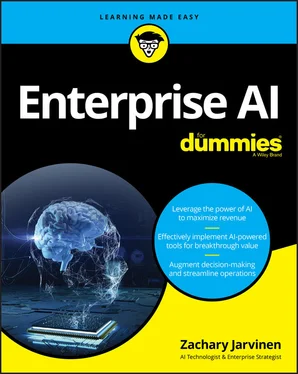Chatbots, also called chatterbots, are text-based applications or plugins that replace the human side of a conversation with artificial intelligence. Chatbots are frequently used on websites to provide tier-one technical support, schedule appointments, find a specific product, and other simple tasks that can be accomplished without human intervention. Early implementations had a limited ability to parse language and thus required the user to formulate a question with a very specific syntax and vocabulary. Deep learning based on intent recognition has expanded the utility of chatbots by freeing the user to ask questions in everyday language.
 Unlike virtual assistants such as Siri, closed-domain chatbots are trained as experts in a specific field and can resolve a large volume of questions and requests simultaneously and continuously, tying into a customer relationship management platform and allowing call center employees to focus on more nuanced issues.
Unlike virtual assistants such as Siri, closed-domain chatbots are trained as experts in a specific field and can resolve a large volume of questions and requests simultaneously and continuously, tying into a customer relationship management platform and allowing call center employees to focus on more nuanced issues.
While many of these examples could be typified as business-to-consumer applications, AI began making inroads into enterprise and medical environments as early as the 1970s. Many of these applications use supervised learning, unsupervised learning, or a combination of both.
When Amazon launched in 1995, it sold only books and didn’t have features such as “If you bought that, you might like this” or “Other people who bought that also bought this.” Those features emerged a few years later and have expanded to nine different types of recommendation. Amazon doesn’t publish numbers on their recommendation engine, but in 2013, McKinsey estimated recommendations were responsible for 35 percent of Amazon sales. Two key breakthroughs in use of recommendations were the following:
In 2001, Yahoo applied recommendation engines to streaming music with Yahoo LAUNCH, later rebranded as Yahoo Music and then Y! Music. Four years later Pandora went live, its recommendation engine powered by the music genome project, a manual classification system conceived by the founders in 1999.
In 2007, Netflix applied the recommendation engine to streaming video, powered by the CineMatch algorithm, which Netflix said was accurate to within half a star 75 percent of the time. In 2009, the company replaced CineMatch with Pragmatic Chaos, an algorithm developed by BellKor as a submission for the Netflix Prize competition, a $1 million contest for the first person or team that could beat CineMatch.
Attempts to apply AI to medicine date back to the 1970s, but a wealth of data is a fundamental prerequisite for effective AI, and the real push to digitize medical records and test results didn’t gain momentum until the twenty-first century. It’s no surprise that the primary application is diagnostics. A 2013 review of three large U.S. studies reported that about 12 million patients, roughly 5 percent, are significantly misdiagnosed per year.
Currently, AI brings machine learning, natural-language processing, and other AI techniques to medical diagnosis.
Traditional breast cancer screening tests involve radiologists examining X-ray film for telltale signs of cancer. It is reliable most of the time, but it produces false negatives (20 percent of the time radiologists fail to find cancer when it is present) and false positives (a false alarm where radiologists mistakenly conclude cancer is present). About 50 percent of women who do annual mammograms get at least one false positive in a ten-year period.
In 2020, Google Health used DeepMind to train a model to recognize cancer in mammogram X-ray in U.K. patients. Compared to human radiologists, it reduced false negatives by 2.7 percent and false positives by 1.2 percent. When they extended the project to U.S. patients, the model reduced false negative by 9.4 percent and false positives by 5.7 percent.
Network intrusion detection and prevention
Hackers and cyber-crime date back to the 1970s, but things have changed a lot since Matthew Broderick hacked into a government computer to impress a girl and almost annihilated the planet in War Games . (Spoiler alert: Regarding playing the game, the computer comes to its conclusion through the use of reinforcement learning, the same AI technique used to train computers to beat human experts at chess and Go, and to train robots to walk.)
Back in the real world, it took the proliferation of the Internet and the dawn of e-commerce to provide the incentive for electronic malfeasance on a global scale. Conventional network intrusion detection systems (NIDS) and network intrusion prevention systems (NIPS) detect and prevent network attacks.
However, these systems have a significant usability issue in the triggering of false positives, marking legitimate traffic or behavior as an attack and requiring human intervention to respond to the anomaly and mark it as safe. A 2018 SANS survey found that in the face of a false positive rate of 50 percent, many security teams have taken to tuning the security settings to reduce the number of alerts. The problem with this practice is the potential to increase the number of false negatives, identifying a breach as harmless traffic — and it only takes one breach to cause a world of hurt.
As early as the mid-1990s, designers began exploring AI techniques, including unsupervised machine learning and artificial neural networks, to improve protection while reducing the need for human intervention. AI offers these capabilities:
AI leverages supervised learning and, especially, artificial neural networks to build a massive library of markers of hostile code, and then it scans incoming data for matches.
AI uses machine learning and security analytics, including user and entity behavior analytics, to detect external and internal risks earlier and more accurately than a traditional rules-based approach.
Some systems use natural-language processing to repel text-based attempts to trick users into replying with sensitive information via email and messaging by pretending to be from a legitimate source, such as a tech support agent, bank, or government agency, also known as phishing attacks.
Fraud protection and prevention
Anyone who has seen It’s a Wonderful Life remembers how nervous everyone became when the bank examiner showed up at Bailey Building and Loan. He walked in with a briefcase and spent hours going over financial statements. These days, he might show up with a laptop and a scanner and let the algorithms process the paperwork and identify anomalies and violations of federal and state regulations.
As a field that is driven by well-defined practices, structured data, and pro forma documents and reports, the finance sector is well aligned for automation, and in light of the financial crises of 2000 and 2008, the emergence of practical AI is timely. The “2018 AFCE Global Study on Occupational Fraud and Abuse” reported a loss of $7 billion due to fraud in 2018 alone.
Recent approaches to fraud prevention use a range of AI tools, including data mining, supervised and unsupervised machine learning, behavioral analysis, link analysis, regression, decision trees, neural networks, and Bayesian networks.
Over the past five decades, AI has evolved from offering lightweight consumer applications or add-ons to supplementing and performing mission-critical and even life-or-death functions. The next sections introduce some of the ways AI is changing the landscape for the enterprise.
Benefits of AI for Your Enterprise
Читать дальше

 Unlike virtual assistants such as Siri, closed-domain chatbots are trained as experts in a specific field and can resolve a large volume of questions and requests simultaneously and continuously, tying into a customer relationship management platform and allowing call center employees to focus on more nuanced issues.
Unlike virtual assistants such as Siri, closed-domain chatbots are trained as experts in a specific field and can resolve a large volume of questions and requests simultaneously and continuously, tying into a customer relationship management platform and allowing call center employees to focus on more nuanced issues.










